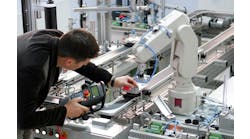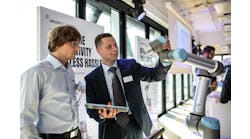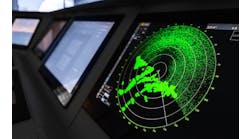We're integrating an ambitious manufacturing line project that has us a little out of our depth for one element of it. We use proximity and other presence sensors on our machines all the time, but we're being asked to spec presence sensing to detect unauthorized personnel in the areas where all the machines will operate. First glance shows us many pros and cons among several technologies: the more conventional photo cells that we know something about, but also laser-based sensors and infrared sensors. Anyone have some best/worst practices about these two?
—From May '12 Control Design
Answers
A Range of Sensing Options
There could be a number of reasons behind the need to detect unauthorized personnel in a specific plant floor area. One reason might be the security of intellectual property and the prevention of industrial espionage. The other reason might be personnel safety.
In the case of securing an area from prying eyes, a consideration is whether select personnel are authorized to be in the restricted area, or absolutely no one is permitted to enter. If only select personnel are permitted, some type of actively monitored access control scheme is called for. If no one is permitted to enter, an approach similar to an intrusion alarm system might make sense.
Typical intrusion detection systems use infrared motion sensors to detect a change in the static IR signature of the monitored area. Essentially, a human being moving across the field of view generates a dynamically changing IR signature, which triggers the alarm. Some IR motion sensors employ monitored, battery-operated wireless technology, which might solve some installation issues where hardwiring is not an option.
We've used leadscrews in our linear motion applications for years because they give us high stiffness, very acceptable backlash, and simplicity. As performance requirements increase, we're going to have problems with the leadscrew not accelerating quickly enough to high speeds. It looks like we have some torsional issues as well. Can we overcome this with better sending and control? Is it time to look to an electronic answer?
Send us your comments suggestions or solution for this problem.
A lot of people have a misperception that lasers are the most powerful light source for sensors. In fact, most lasers used for sensing applications — especially visible, red-light lasers — are not extremely powerful for reasons of personnel eye safety. Also, laser through-beams are rather susceptible to false/nuisance triggering because of flecks of dust and water droplets interrupting the beam.
Another long-range presence-sensing technology to consider is ultrasonic. Many ultrasonic sensors have an adjustable set point, so you can tune it to ignore objects beyond the adjusted sensing range.
With respect to detection of personnel for safety reasons, the only approach is to follow government regulations and industry guidelines. Depending on the situation, safety light curtains, safety floor mats, safety area scanners, safety gate interlock switches, etc. may be needed to provide an appropriate level of personnel protection.
Henry Menke,
marketing manager, object detection, position sensing and measurement,
Balluff
Safety Expert Recommended
In any application where personnel must be detected for safety purposes, the use of standard photo sensors is not appropriate. Without seeing your actual application, it is difficult to suggest the correct safety-rated presence sensing device.
However, there are basically three choices to consider for safety-rated devices. First are safety light curtains. These devices can be mounted either vertically or horizontally to detect the presence of a person. When used in a vertical position, the device will detect when a person crosses through the light curtain and will act to stop the machine. If the area the person is entering is such that they may cross through the light curtain and remain undetected in the hazardous area, then the use of a light curtain alone is probably not adequate. Light curtains could be used horizontally to detect a person in the area between the transmitter and receiver, but in those cases one of the other two technologies are more appropriate.
Second are safety mats. These devices detect the presence of a person when stepped on. These are often a cost-effective way to guard a specific area and prevent machine operation when a person is in the hazardous area. Safety mats come in a variety of sizes to allow custom configurations to ensure the entire area is protected.
Third are safety laser scanners. These devices can be used either horizontally or vertically as well. They use a reflective technique to detect the presence of a person in an area. Used horizontally they can be configured to guard a variety of shapes. The use of a laser scanner can be very effective when the area to be guarded is an odd shape or may be reconfigured. Laser scanners are susceptible to certain environmental issues such as dust or smoke, so the application must be evaluated.
It would seem that one of these technologies would be appropriate, but there are other issues involved in selection and system interface when personnel safety is involved. We would recommend that you consult a safety expert before proceeding with a selection. That person would be able to evaluate the risks involved and recommend the most appropriate solution.
Richard Harris,
manager, channel relations,
Omron Automation and Safety
Safety vs. Security
This question could be answered in two ways, depending on whether your primary goal is security (controlling access to specific areas based on employee clearance) or safety (preventing employees from entering potentially dangerous areas associated with machines).
If security is your main goal, the application calls for user authentication to control access — and an RFID system could be the answer. Employees are issued RFID badges that must be scanned at access points. They are granted access based on their roles as well as access rules established in the system. These access rules are often based on employees' specific training, verifying that they understand proper machine operation.Information in the tags could also be used to track product cycles, length of time at a machine, number of parts built per shift, and who has used the machine.
However, if your primary goal is personnel safety, the application calls for specific safety-rated sensors and switches. These components are designed to shut down or slow machine movement when personnel are in the area, preventing injury. Solutions could include hard-guarding (such as gates and fences) with safety interlock switches at all doors and access points, optoelectronic sensors (such as laser scanners, light curtains and safety cameras), as well as pressure-sensitive safety mats and edges.
The best solution might be a combination of these applications. Some solutions integrate safety and RFID functionality to provide a combination of safety and access control. For machine-safety applications, the best practice is to perform (or hire an expert to perform) a risk assessment for the machine(s) to identify and rate the severity of hazards. You then can confidently design a safety control system that best suits your needs.
Kevin Zomchek,
manager, sensing & connectivity RFID,
Rockwell Automation
Sponsored Recommendations

Leaders relevant to this article:




